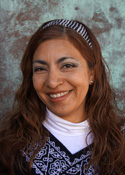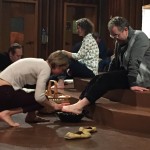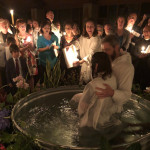From the Senior Warden
Vestry Reflections
Our most recent vestry meeting was held on Wednesday, March 20th in the All Souls Common Room. Ten vestry members were present, with one additional member joining us by phone. The bulk of our meeting was spent in conversation with two candidates for ordination put forward by the vocations committee, as well as consideration of the 2018 Parochial Report.
In administrative business, the vestry accepted the Treasurer’s Reports and financial statements from January and February. At the treasurer’s request, we adopted a Corporate Banking Resolution to officially transfer the office of the treasurer’s authority from Marilyn Flood to Vimala Tharisayi, who now serves in that capacity.
We then considered the Parochial Report for 2018, a document that all Episcopal parishes prepare to reflect and report on their prior year’s activities. We discussed membership and found that in 2018 we incorporated significant numbers of new members into the congregation, while also saying goodbye to several members and sending them off to new adventures. In the end, we arrive where we started by the numbers; 604 members in 2018 as compared to 605 in 2017. We reflected on the opportunities this can offer for new relationships and renewed energy, as well as the challenges for ensuring new members are incorporated into the close ties of our community.
One of our inspiring roles as vestry is to hear from and discern with the candidates All Souls puts forward for ordination to holy orders. At several steps in the process, the vocations committee brings people to the vestry for approval to move forward. This month, we met with Ari Wolfe and heard about her process to pursue ordination as a vocational deacon. She has been practicing various aspects of that ministry at Church of the Good Shepherd while completing a Masters of Theology at CDSP focused on diaconal ministries. The vestry approved her application to become a candidate, the next step after being a postulant.
We also met with Nikky Wood and heard about her final formation steps as she moves from candidacy to being put forward for ordination to the transitional diaconate. Nikky shared how she has seen values-based formation in a new light while working with her son’s preschool, learning from integrated pedagogies for supporting literacy and wondering how church communities might be similarly intentionally crafted around supporting Christian formation. The vestry approved Nikky for ordination to the vocational diaconate and wishes her well on the next steps of her journey, which may be to be placed at another congregation as a transitional deacon who would then put her forward for ordination to the priesthood.
Next month we look forward to conversations with the Parish House Project team and with Emily Hansen Curran, who will share about her work to incorporate newcomers and pilot the Emmaus small groups. The next vestry meeting will be on Wednesday, April 10th, at 7:30 pm in the All Souls common room.
— Laura Eberly
Psalm 23, 4.0
Have you noticed? Maybe it slipped past you. We each have so much going on in our lives and even if we are fully attentive in worship, we still might not be making the connection. During the celebration of the Eucharist, as everyone is coming forward, the Choir has been singing settings of Psalm 23.
Every. Sunday.
The first was Tomkins “My shepherd is the living Lord.” Next was Bairstow’s setting of the familiar hymn tune, “The king of love my shepherd is.” Did you hum or sing along? Then we sang the less familiar but no less beautiful setting from Howells’ “Requiem.” This Sunday we will sing the setting from Rutter’s “Requiem.” Finally, version 5.0 will be Bobby McFerrin’s setting of the Psalm which features feminine imagery. He wrote it for his mother. It’s a lovely homage to God and how McFerrin perceived God’s presence in the life and presence of his mother.
I asked Jamie why he scheduled all these settings. He said, “Some people enjoy the experience of finding new ways into familiar texts over a concentrated period of time.”
Yep. There you go.
Now, he’s the one with the PhD in the history of English choral music. I’m an ethnomusicologist with an unhealthy interest in banjos, Jesus, and the people who love them…at the same time. So, though we’re both pretty nerdy, Jamie’s expertise in the history of these settings far outshines my own. That said, I am obsessed with the kind of meanings we make from music, the arrangements, styles, communities who play or sing the music, and what we do with the various sounds we encounter.
A common trope around some corners of the Christian musical world is that the notes, the music, if you were, is not meaningful. Sounds have no meaning until we add text. I cry, “Hooey!” Why?
Well, we make tremendous meaning with the sound itself and not just the words. Go ahead and ask someone at church why they prefer organ accompaniment for a specific hymn over my banjo picking. I won’t be offended. Go ahead. People will have different responses, of course, but you’ll hear descriptions of the sounds that the instruments make, the way they support singing the hymn, and the other associations people make. This is meaningful stuff. We don’t just hear the lyrics and think, “this song means [insert text here].” No, there’s much more going on. The music adds meaning to the text just as much as the text adds meaning to the music.
Some folk would go so far as to say more so.
So, here we are walking through all these settings and as a musician, I wonder how many of you have noticed. And, if you have noticed, what has it been like for you? Has the meaning of the Psalm and your associations with it been expanded in any way? Have you been stretched? Confused?
I jokingly titled this missive “Psalm 23, 4.0” because, well, welcome to a digital age, the Silicon Valley, and this Sunday we’ll present the fourth setting of the psalm. Mind you, unlike your basic software company, these arrangements are not intended to be improvements upon one another. Instead, they are simply…different. From a different time, era, and community. We’re performing them in a worship setting some of the composers might not have imagined. Or we are. But does it matter? Perhaps. Most of that is up to you, the hearer.
So, this is my invitation to you all. Listen closely this Sunday if you are able. Note what you hear and how it feels or what kind of things come up for you. If you can, recall the other settings. Save this one in your mind. Hold on to it. Next Sunday, hold them all together with the McFerrin setting. Then, sit down and read Psalm 23 and notice if the psalm has changed for you in any way. What does it mean now?
— Tripp Hudgins
Getting Closer to the Mystery
 “We seek, name and celebrate Jesus’ loving presence in the stories of all people – then invite everyone to MORE.”
“We seek, name and celebrate Jesus’ loving presence in the stories of all people – then invite everyone to MORE.”
This simple, yet bold statement was crafted by members of Presiding Bishop’s Evangelism Initiatives Team as a practical definition of how Episcopalians understand and define Evangelism. “At the heart of our Christian faith is the Great Story, the collection of stories of God’s creating, redeeming work in scripture, especially in the story of Jesus. We are all part of this Great Story – all made in God’s image, all moving through a world shot through with God – but we need to grow our capacity to seek, name and celebrate God at work in our own lives.” (Introducing a Practical Theology of Episcopal Evangelism at episcopalchurch.org).
For the last 3 weeks of Lent, and as we get closer to the Mystery of Easter, we invite you to get ready by reflecting on your faith story. Each week, you will find pew cards with simple prompts:
Week 1. This week, take some time to write down your faith story.
- How did you hear about Christianity/The Episcopal Church/All Souls?
- Why did you enter church/this church?
- Who told you about church/God/faith?
Were there other influences on your faith development?
Week 2: This week, tell your faith story to someone else in church (or elsewhere) and listen to theirs.
How are your stories similar and different?
Do any themes emerge?
What is it like for you to share your story?
Week 3: This week, think and pray for people in your life outside All Souls that might be going through a difficult time. Think of people in your circles that might be longing for more Christian community (worship, outreach, formation class). Take an extra clay cross, a Prayer card, a sticker or a postcard from the Narthex, and share it with someone. Pray for them.
We invite you to practice seeking, naming and celebrating God’s presence in your own story.
— Toni Martinez Borgfeldt
Holy Week: Start Building Now
We are deep into Lent. Holy Week is around the corner. And sometimes it seems like it can come so fast, it takes us by surprise. The thing is, it is really difficult to enter into Holy Week if we are not deliberate about it. Holy Week does not fit neatly into our lives, conveniently slipping in between conference calls and shuttling kids around, between this doctor’s appointment and those household responsibilities. These holy days are an entity unto themselves, and if we want to really walk them, live them, have the chance to be transformed through them? We have to plan ahead. Working out how to come to church on Sunday, and then again on Thursday, Friday, Saturday, and again on Sunday, all in one week, is no small feat — and it is so worth it. So, here is an overview of what’s happening when, that you might start building your life around these practices now.
Palm Sunday – April 14th
 Holy Eucharist with Procession of the Palms
Holy Eucharist with Procession of the Palms
7:30 am (chapel) and 9:00 and 11:15 am (main church, beginning in the courtyard)
At each service, we will begin outside. Everyone is given palms to wave as we sing and process into the church, remembering the crowd’s excitement when Jesus returned to Jerusalem for the last time. We will gather to retell the Passion Gospel – this ancient story of betrayal, fear, power, and lament. Between the 9 and 11:15 services, we’ll also gather for a Continuing the Feast brunch.
Maundy Thursday, April 18th
 Holy Eucharist with Foot washing
Holy Eucharist with Foot washing
12 noon and 7:30 pm (main church)
We remember Jesus’ last meal with his friends, and his bold commandment to love one another as he loves us – tenderly, in service, with humility. All who wish are welcome to come forward to have their feet washed and to offer the same care for another. The evening service concludes by processing outside and down to the chapel where consecrated bread and wine, the outward and visible sign of the presence of Christ, will be placed. The chapel is filled with flowers and plants reminiscent of the Garden of Gethsemane and parishioners keeping vigil there through the night until Good Friday. The noon service is simpler, with spoken word. The evening service includes a wide range of music.
Good Friday, April 19th
 9:00 am: Simple Good Friday Liturgy (chapel)
9:00 am: Simple Good Friday Liturgy (chapel)
12:00 – 3:00 pm: Contemplative Good Friday (main church)
4:00 pm: Holy Week for Children Service (main church)
7:30 pm: Solemn Good Friday Service
On Good Friday, we slow down to mark Jesus’ death and our participation in it. We pray, we repent, and we venerate the cross – this awful symbol of execution, yet one that also brings liberation. At each of these services, there will be opportunity to pray with a large wooden cross and cover it with petals as a sign of our devotion. The 9:00 am service is simpler, with spoken word. The 7:30 service offers more sweeping music to ground our worship.
The Contemplative Good Friday Service, from 12 noon – 3:00 pm, offers a mix of scripture, poetry, personal reflections from parishioners, music, and silence. Worshipers are invited to move about the sanctuary freely, praying with icons or the Stations of the Cross, which this year are a collaborative photo collection. Many people only come for a portion of this service – feel free to come when you are able.

The Holy Week for Children Service, at 4:00 pm, is intended for kids roughly preschool – 3rd grade, though older and younger siblings are certainly welcome. It traces the arc of Maundy Thursday and Good Friday through music, prayer, Godly Play storytelling, with foot washing and a response in art. It will last less than an hour.
Easter Vigil, April 20
8:30 pm (beginning in the courtyard)
The Easter Vigil is a night unlike any other. We begin as dark falls out in the courtyard, where we kindle the new fire of Easter, light incense, and bring candles into the darkened church.
We retell the stories that make up our faith, interspersed with ancient midrash, contemporary poems, and much music.
We celebrate immersion baptisms — not a common sight in Episcopal Churches,  but a practice we have found to deeply reflect this profound way we are committing ourselves to living.
but a practice we have found to deeply reflect this profound way we are committing ourselves to living.
We remember the saints who have gone before us as we process down Cedar Street, and return to a bright church and the ringing alleluias of Easter. (Bring bells!) We share communion, joyful to be feasting again. It’s a long service — outside of time, really — with sweeping music and a festive reception to follow. This night is the heart of Easter for us. It is the core of who we are.
HOLY WEEK: THE TRAILER
For one Sunday only (!), April 7th between the 9 & 11:15 services, come together for a preview of Holy Week. Starting with Palm Sunday, including Maundy Thursday, Good Friday, the Great Vigil of Easter, and finally Easter Sunday, Phil+, Liz+ and Michael+ will share a glimpse of each service, why it matters to them, and how we might think about entering in and practicing anew. Use this as a time to prep for what’s to come. Class will meet in the Parish Hall.
Palm Sunday — Continuing the Feast
Join us on Sunday, April 14th between the 9 & 11:15 services in the Parish Hall for a Continuing the Feast potluck brunch! This is just a good, fun time to catch up, share fellowship, and launch into Holy Week together. Please bring some brunch type foods to share!





